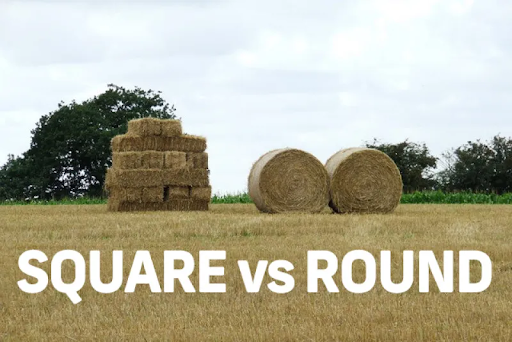Introduction: How Many Square Bales in a Round Bale
Understanding the relationship between square and round bales is crucial in agriculture. The question, “How many square bales are in a round bale?” often arises, prompting an exploration into conversions.
This article aims to demystify this query, focusing on specific sizes like the 4×5, 4×4, and 5×6 round bales.
A. Exploring the Square-to-Round Bale Conversion
Farmers and enthusiasts often seek to comprehend the dimensions of square and round bales, particularly the equivalence of square bales within a round bale.
B. Delving into Different Round Bale Sizes
Round bale dimensions significantly impact the quantity of square bales they hold. Whether it’s the common 4×5, the smaller 4×4, or the larger 5×6 round bales, each size presents its formula for calculating square bale equivalents.
The inquiry into how many square bales in a 4×5 round bale or how many square bales in a 4×4 round bale prompts nuanced calculations and considerations about their capacities.
Stay tuned as we explore each round bale size in detail, uncovering the secrets behind these conversions and explaining the factors influencing square bale counts within round bales of different dimensions.
How Many Square Bales Are in a Round Bale?
When it comes to determining the number of square bales within a round bale, understanding the dimensions plays a pivotal role.
Let’s delve into the specifics of different round bale sizes, focusing on the 4×5 round bale, the 4×4 round bale, and the 5×6 round bale, to decipher their square bale equivalents.
A. Calculating Equivalents: Exploring the 4×5 Round Bale
How many square bales in a 4×5 round bale? On average, a 4×5 round bale typically accommodates around 8 to 10 square bales within its structure.
However, this count can vary based on factors like bale density, forage type, and handling practices. The 4×5 round bale’s dimensions allow for a higher capacity compared to smaller round bales.
B. Analyzing the 4×4 Round Bale
How many square bales in a 4×4 round bale? A 4×4 round bale generally holds approximately 6 to 8 square bales, depending on factors such as compression techniques, forage type, and regional variations.
The smaller size of the 4×4 round bale limits its square bale capacity compared to larger-sized round bales.
C. Insights into the 5×6 Round Bale
How many square bales in a 5×6 round bale? The larger dimensions of a 5×6 round bale allow for a greater capacity, accommodating roughly 12 to 15 square bales.
However, this estimation can vary due to factors like bale compression, forage type, and handling methods.
These estimations based on industry standards and common practices provide a general idea of the square bale equivalents for different round bale sizes, aiding in agricultural planning and understanding the capacities of various bale types.
Insights into the 5×6 Round Bale
When it comes to the 5×6 round bale, determining the equivalent number of square bales involves understanding its specific dimensions and the factors that influence its yield.
Understanding the Conversion Rate for 5×6 Round Bales
A 5×6 round bale typically denotes a bale with a diameter of 5 feet and a length of 6 feet. To gauge the number of square bales it might equate to, the calculation involves considering the density and compression of the hay or forage within the bale.
The main query—how many square bales are in a 5×6 round bale—varies based on several aspects. On average, a 5×6 round bale may contain the equivalent of [insert estimated range] square bales, but this estimation can fluctuate.
Factors Influencing Yield
Several elements affect the yield or count of square bales within a 5×6 round bale:
- Bale Density: The density at which the forage is baled significantly impacts the number of square bales it can represent. Higher-density bales might contain more material, thus potentially equating to a greater number of square bales.
- Forage Type and Conditions: The type of forage used and the conditions it was harvested play a crucial role. Different types of hay or forage may compress differently, affecting the overall bale size and consequently, the square bale count.
- Storage and Transportation Impact: The handling and transportation of the round bales can impact their shape and density. Compression during storage or transportation may alter the bale’s structure, affecting the estimated number of square bales it represents.
Understanding these factors assists in estimating the number of square bales one might expect from a 5×6 round bale, though it’s essential to note that this figure can vary based on the mentioned variables.
For accurate estimations, it’s advisable to consider these influencing factors and, when possible, consult with suppliers or use guidelines provided by manufacturers to determine a more precise square bale count for a 5×6 round bale.
Tips for Accurate Bale Count Estimates
When gauging the number of square bales within a round bale, precision is key. Employ these expert strategies to estimate square bale equivalents effectively, especially concerning various round bale sizes like the 4×5, 4×4, and 5×6:
A. Use Bale Dimensions for Estimation
Begin your estimation process by leveraging the known dimensions of the round bale. For instance, a 4×5 round bale indicates a 4-foot diameter and 5-foot height.
Consider the typical size of square bales used in your region, often around 2 feet by 2 feet by 4 feet. Divide the round bale’s dimensions by those of a square bale to estimate the potential count.
B. Refer to Manufacturer or Supplier Guidelines
For precise estimations, turn to guidelines provided by bale manufacturers or suppliers. These experts offer insights into compression ratios used during baling and recommended square bale equivalents within different round bale sizes.
They might also furnish formulas or conversion factors tailored to specific bale types.
C. Account for Field Conditions and Handling
Factor in field conditions and handling methods. Variations in forage types and baling techniques can affect bale density.
Moisture content, compression force during baling, and post-baling storage conditions all influence how many square bales fit within a round bale. Consider these variables to refine your estimate.
Combining these strategies will help you better estimate the number of square bales within round bales of varying sizes, whether it’s a 4×5, 4×4, or 5×6.
Remember, while calculations offer estimations, variations in bale density and handling practices can influence the final count. Aim for a range to accommodate potential differences.
Conclusion:
Calculating how many square bales fit into round bales involves looking at their sizes and how tightly they’re packed. Different round bales, like the 4×5 or 5×6, need different ways of estimating square bale equivalents.
The size, density, and type of stuff inside the bale affect how many squares fit. While it’s not always exact due to these differences, understanding these factors helps get a good idea.
For farmers, knowing this helps with storing and using baled stuff more efficiently. It’s a handy tool for making farming easier and more efficient.
Understanding how square bales fit into round bales helps farmers make better choices for their fields and save time and space.

